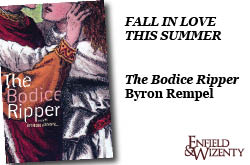The metaphor of mountains as cathedrals and nature-lovers as pilgrims has been around at least since Wordsworth and Co. popularized hiking in Britain’s Lake District. John Muir, founder of the Sierra Club and godfather to the environmental movement, brought it to North America when he referred to himself as a pilgrim and urged his readers to “climb the mountains and get their good tidings.”
So BC novelist Angie Abdou is following in a long tradition by imagining a backcountry ski trip as a pilgrimage in her second novel, The Canterbury Trail. In fact, many of her literary influences predate Muir and Wordsworth by several hundred years, as she takes readers on a pilgrimage through medieval literature.
The Canterbury Trail brings together a motley collection of ski bums, hippies, yuppies, poseurs and snowmobile-riding rednecks on a late winter trip into the mountains around the fictional Coalton, B.C. Coalton is a close fit with Abdou’s home of Fernie, a powder-skiing haven that uneasily combines an economic base of coal mining with a mountain escape for Calgary’s moneyed classes.
Abdou, a University of Calgary PhD graduate in English, rose to prominence this winter when her first novel, The Bone Cage, was featured on CBC Radio’s Canada Reads. The Bone Cage was the story of two female athletes preparing for the Olympics and coping with pain and injury. Her new novel is also a sweaty affair, as well as a literary one. Her characters ski, snowshoe or snowmobile up the trail of the title to a backcountry ski hut known as Camelot, where, like the pilgrims in Chaucer’s tales, they engage in ribaldry, intoxication and story-telling. There’s even a (lumberjack) Miller’s Tale.
At the same time, Abdou’s characters are on a quest for healing and meaning that calls to mind Arthurian legend.
The place names in the backcountry getaway were bestowed by a former English teacher turned hermit, who also named his own mountain shack after Heorot, the hall from Beowulf. The Hermit, Heinz, is a kind of Wounded Knight figure, perhaps, waiting for a pure-hearted quester to heal him. The same could be said for the skiing, snowshoeing and snowmobiling pilgrims, who have been drawn to the mountains by something more powerful than the lure of powder.
“Clearly, there have been wounds,” lesbian hippie Cosmos announces to the group, as she attempts to defuse one of the many fights between snowmobiling rednecks and pot-smoking ski bums. Those wounds are rubbed raw in drunken arguments in the overcrowded ski hut. But we also see how being in the mountains may heal them, when characters rise to greater levels of maturity, compassion and understanding.
So, is nature a kind of Holy Grail, sipping from which will miraculously cure us of our psychic wounds? Well, perhaps not. By bringing in Beowulf, Abdou adds to the mix older and darker ideas of nature as a relentless monster that, even if defeated in one form, will get you in the end.
“Nature never did betray the heart that loved her,” intoned Wordsworth in “Lines Written a Few Miles Above Tinturn Abbey.” But Wordsworth never travelled in avalanche country. Every winter nature betrays, in rather dramatic fashion, the hearts of a dozen or two of her lovers in the snow-covered backcountry of British Columbia and Alberta.
Or, as Cosmos would describe nature: “…she’s a woman and she’s pissed off.” The ever-present threat of cold death lies over the novel whenever the characters leave the boozy confines of the backcountry ski hut.
Indeed, the impersonal force of nature stands in mute contrast to the vocal conflicts among the characters. As much as they argue about who is local and who’s a “gorb,” who has the right to be in the mountains and who’s a poseur, nature is ready to bury any or all of them under a fatal blanket.
The clashing personalities give Abdou a chance to explore the economic and cultural conflicts of a skiing and mining town. Michael, a former ski bum turned real estate developer, complains that Coalton’s mining industry is holding back much-needed development. Locally grown ski bum Loco – who’s about to give up his ski bum life to follow his family destiny as a miner – angrily asks: “Are you fucking retarded?… Tourism doesn’t keep a community alive. Those jobs pay $8.50 an hour. That’s what they pay. You tell me how you’re gonna support a family on that? Not when the houses cost a million dollars. The only ones making any money on your scheme – the only ones living – are the punks selling those million-dollar houses, the punks like you.”
It’s a legitimate point and one worth bringing up whenever a depressed primary industry town – Kenora, take a bow – turns to tourism as its future. Mountain towns like the fictional Coalton bring so many economic and cultural questions into focus that it’s surprising how few mountain towns there are in Canadian literature in comparison to the many fishing and farming towns.
But as much as they are divided by economics, class, and culture, Abdou’s pilgrims are all searching for the same thing, and it’s not just primo powder. They’re all looking for belonging
On the surface, the characters are stock mountain-town types – “Some lazy, stoned ski bums, some flakey, tarot-card waving hippies, and some rye-guzzling, oil-burning rednecks.” Abdou’s accomplishment is to show the uncertainties and insecurities that lie beneath those surfaces.
Anybody with any mountain experience can check off the mistakes they make in their trip. Late start. Conflicting goals. Lack of group cohesion. Skiing while hampered by hangovers. And yet she makes us care whether or not they find their magical chalice and make it back from their pilgrimage.
Brindle & Glass Publishing | 288 pages | $20 |paper | ISBN #978-1897142509






One Comment
I would just like to say that I love this review. Thank you, Bob Armstrong. There’s nothing better than someone really “getting” your book.